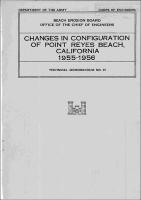Please use this identifier to cite or link to this item:
https://hdl.handle.net/11681/3461| Title: | Changes in configuration of Point Reyes Beach, California, 1955-1956 |
| Authors: | University of California, Berkeley. Wave Research Laboratory United States. Army. Office of the Chief of Engineers Trask, Parker D. (Parker Davies), 1899-1961 |
| Keywords: | Point Reyes Beach, California Sand testing Sand analysis Beach erosion Beach sampling |
| Publisher: | United States, Beach Erosion Board Engineer Research and Development Center (U.S.) |
| Series/Report no.: | Technical memorandum (United States. Beach Erosion Board) ; no. 91. |
| Description: | Technical Memorandum Abstract: Point Reyes Beach is a highly variable beach, characterized by steep slopes, high berms and prominent cusps. It has been surveyed in the present study 8 times between August 1955 and June 1956. The sands are coarse, ranging from a mean of 560 micron (0.38 phi units) in Pebruary to 770 microns (0.84 phi units) in October. Intervening months have intermediate grain sizes. The general variation or standard deviation of the samples on the beach ranges generally from 0.30 to 0.35 phi units, which indicates that the median diameter of two-thirds of the samples on the beach at any one time ranges within 20 to 25 percent on either side of the mean for the beach. At times the beach is more variable than indicated above, and gravels with phi diameters of minus 3 (8 millimeters) are found on the beach. The sediments at all times are more poorly sorted than normal beach sands, as the mean coefficient of sorting ranges generally between 1.27 and 1.30, in contrast with 1.20 or less for many beaches. No distinctive difference in sorting is observed between seasons. The sediments are evenly skewed. The sediments on the lower foreshore are more coarse grained and better sorted than the sediments on the upper foreshore or berm. The deposits in the swales or bays between cusp points are more fine grained than on the foreshore or on the berm adjacent to the cusp points. The cusps range in height from 12 to 17 feet above mean low water and average 15 feet. The horizontal interval between cusps ranges between 60 and 250 feet, with an average of 160 feet. The cusps change location on the beach from time to time. The average position of the cusps ranges within an interval of 50 feet measured normal to the coast line, and the maximum variation in position occurred within a period of 6 weeks between May and June 1956. Individual cusps or parts of the beach may advance or retreat a maximum distance of 160 feet. The cusps are actively eroded at times, particularly when low berms form on which the waves cut scarps as much as 5 feet in height in the preceding berm. At other times the cusps and beach are built up rapidly. As much as 8 inches of fill in 4 hours and 12 inches in 18 hours has been observed. The maximum fill at anyone place in an interval of 6 weeks is 7 feet and the maximum cut is 10 feet. The winter months are periods of active cutting and summer months a period of fill. The slopes on the beach are generally steep. In the swales between cusps the slopes are commonly 4 to 8 degrees, and on the slopes off the points of the cusps, from 6 to 15 degrees, with an average of about 10 degrees on the upper foreshore near the "Reference Point". Where the berm is being actively eroded slopes greater than 45 degrees or 100 percent have been observed. |
| Rights: | Approved for Public Release, Distribution is Unlimited |
| URI: | http://hdl.handle.net/11681/3461 |
| Appears in Collections: | Technical Memorandum |
Files in This Item:
| File | Description | Size | Format | |
|---|---|---|---|---|
| BEB-TM-91.pdf | 6.29 MB | Adobe PDF |  View/Open |